ColorMunki Display Software Para Mac 9,2/10 6463 reviews
X-Rite ColorMunki Display incorporates technologically advanced filter and optical systems, fast measurement speed, and unrivaled color accuracy on all modern display technologies including LED and wide-gamut LCD displays and mobile devices. Cannot create a multi node swarm in docker for mac. It's also spectrally calibrated, which makes it field upgradeable to support future.
| Home · Register · Join Upload & Sell |

| ||||||||
|
| ||||||||||||||||||||||||||||||||||||||||||||
